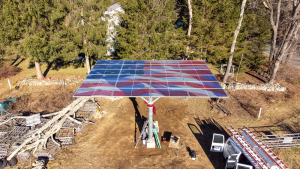
Solar power has become a significant player in the transition toward renewable energy. However, maximizing the efficiency of solar installations is crucial to ensuring their long-term sustainability and effectiveness. While rooftop solar arrays remain popular, ground-mount solar panels are emerging as a favored alternative, particularly when combined with solar tracking systems. Ground-mount systems offer flexibility in location and design, while solar trackers increase the energy output by optimizing the angle at which the sun’s rays strike the panels. We will explore how these systems improve energy efficiency, their benefits, and their potential contribution to sustainable energy practices.
The Advantages of Ground-Mount Solar Panels
Ground-mount solar panels offer several advantages over their rooftop counterparts, making them a more efficient option in various situations. The most notable benefit of these systems is the flexibility in their placement. Unlike rooftop panels, which are limited by a roof’s size, orientation, and condition, ground-mount systems can be positioned wherever conditions are optimal. This flexibility allows for ideal sun exposure, which significantly improves energy production. Ground-mount solar installations are often used in larger commercial or utility-scale projects where space is available. Still, they are also a practical option for residential applications when rooftop installations aren’t feasible.
Another efficiency-related advantage of ground-mount panels is airflow. Elevated above the ground, these systems benefit from increased airflow, which helps keep the panels cool. This cooling effect significantly improves the panels’ efficiency, as solar cells tend to operate more effectively at lower temperatures. In addition, ground-mount systems are generally easier to maintain and clean than rooftop systems, ensuring that debris, dust, and other elements do not hinder their performance over time.
How Solar Tracking Systems Enhance Efficiency?
The introduction of solar tracking systems takes the energy production potential of ground-mount panels to the next level. A tracking system adjusts the position of the solar panels throughout the day to follow the sun’s movement. This capability allows the panels to capture more sunlight, increasing energy generation compared to stationary panels that only operate optimally at certain times of the day. There are two primary types of tracking systems: single-axis and dual-axis trackers.
Single-axis trackers move the panels along one axis, usually from east to west, allowing the panels to follow the sun’s path throughout the day. Dual-axis trackers offer even more precision, adjusting the panels along horizontal and vertical axes to track the sun’s elevation and azimuth. This tracking system is particularly effective in maximizing energy output, as it captures sunlight from a wider range of angles throughout the day and year. Studies have shown that dual-axis tracking systems can increase solar energy production by 30-40% compared to fixed-tilt systems.
While tracking systems add complexity and cost to a solar installation, the increased energy production often justifies the investment. The higher energy yields mean that systems with trackers can achieve quicker payback periods and lower the cost per kilowatt-hour of energy produced. In regions with high solar insolation, these systems become even more valuable, offering a more consistent and optimized energy supply throughout the year.
Durability and Lifespan of Ground-Mount Systems with Tracking
One of the common concerns about adding solar tracking systems to ground-mount installations is the impact on durability and longevity. Since the tracking systems introduce moving parts, they require more maintenance than fixed systems. However, advancements in technology have resulted in highly durable tracking mechanisms that are designed to withstand a variety of environmental conditions. Modern tracking systems have robust components that resist corrosion, extreme weather, and wear over time.
Ground-mount solar panels by North Valley Solar Power are typically easier to access for maintenance, enhancing their longevity when paired with tracking systems. Moreover, innovations in monitoring and automation allow operators to detect issues early and adjust the system to avoid potential problems. For instance, many tracking systems come with sensors and automated controls that will enable the panels to stow during high winds or adverse weather conditions, protecting the system and prolonging its operational life. This combination of technology and design ensures that ground-mount solar systems with trackers produce more energy and maintain their efficiency over time with minimal interruptions.
Environmental and Economic Benefits
Beyond the technical aspects of how ground-mount solar panels with tracking systems enhance energy efficiency, the broader environmental and economic benefits are significant. By increasing the amount of solar energy generated per square foot of installation, these systems can reduce the number of panels required to meet energy needs. This reduction in panel usage decreases the overall material and land requirements for solar farms, allowing more efficient use of space. In addition, generating more energy from the same installation can help offset higher initial costs, making solar energy a more accessible option for both commercial and residential users.
Ground-mount solar panels paired with tracking systems represent a powerful solution for improving the efficiency of solar energy production. Their flexibility in the placement, ability to increase airflow, and enhanced energy capture through tracking mechanisms make them an attractive option for barge-scale and smaller residential installations. While they come with additional costs and considerations, their ability to maximize energy production, particularly in areas with high solar insolation, makes them a valuable investment for the future of sustainable energy.